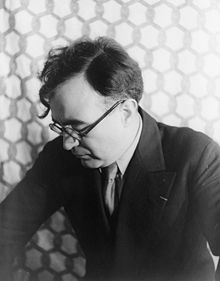|
Piano Concerto (Chávez)
 Concerto for Piano with Orchestra is a piano concerto by the Mexican composer Carlos Chávez, written between 1938 and 1940. HistoryEarly in 1938 Chávez received a grant from the John Simon Guggenheim Memorial Foundation, which provided support for the composition of a Piano Concerto.[1] He set to work in the spring of 1938, finishing the short score by the end of the year. Resumption of work on the orchestration, however, was only possible in October 1940, and Chávez put the final touches on the score on 31 December of that year. The concerto was premiered by Eugene List with the New York Philharmonic Orchestra under the direction of Dimitri Mitropoulos on 1 January 1942. The European premiere was given by Tom Bromley and the BBC Symphony Orchestra conducted by Sir Adrian Boult on 6 September of the same year. The Mexican premiere did not take place until 13 August 1943, with Claudio Arrau and the Orquesta Sinfónica de México conducted by Chávez himself.[2][3] Chávez revised the score in 1969.[4] InstrumentationThe concerto is scored for solo piano and an orchestra consisting of:[5]
AnalysisThe concerto has three movements, played without any breaks:
The first movement represents two-thirds of the entire concerto, and is in a modified sonata-allegro form with a thirty-bar introduction and a cadenza linking the end of the recapitulation to the coda.[6] The movement is modal, predominantly in E Phrygian with excursions to F and G, eventually returning to E Phrygian but with a final cadence on the subdominant, A.[7] The second, slow movement has two main parts, which are preceded by an introduction and concluded with a canonic coda. Harmonically the movement is dominated by quartal harmonies, anchored over pedals of A (bridging from the first movement), D (beginning with and continuing through most of the second section), and G from b. 1221 to the end of the movement. Motivic material is closely related to that of the first movement.[8][9] The finale is characterized by rhythmic drive and intensity, using interrupting rests and short motives to create a sense of instability and tension. It falls into three sections with a coda. The first two parts present distinct thematic material, while the third part combines the substance of the first two parts while adding new material of its own. Harmonically, the movement is largely polymodal, moving in the concluding section to F♯ major.[10] Discography
References
Cited sources
Further reading
External links |